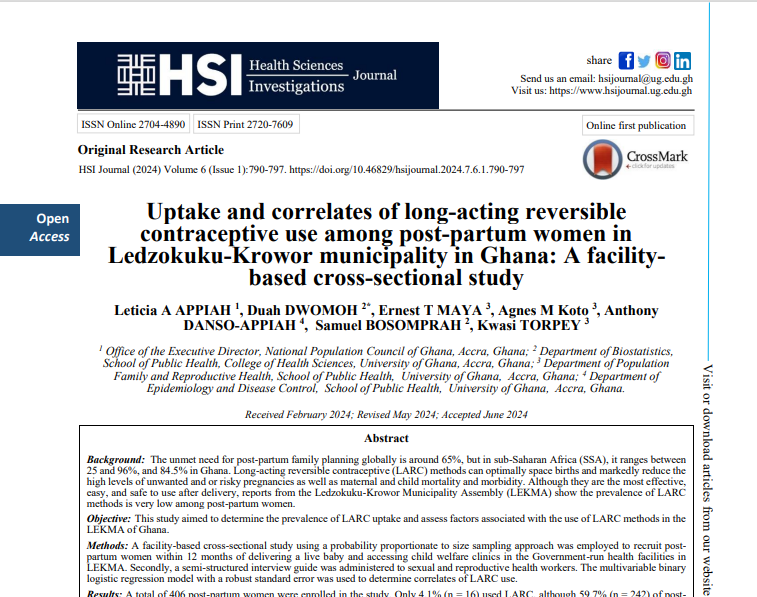Uptake and correlates of long-acting reversible contraceptive use among postpartum women in Ledzokuku-Krowor municipality in Ghana: a facility-based cross-sectional study
Abstract
Background: The unmet need for post-partum family planning globally is around 65%, but in sub-Saharan Africa (SSA), it ranges between 25 and 96%, and 84.5% in Ghana. Long-acting reversible contraceptive (LARC) methods can optimally space births and markedly reduce the high levels of unwanted and or risky pregnancies as well as maternal and child mortality and morbidity. Although they are the most effective, easy, and safe to use after delivery, reports from the Ledzokuku-Krowor Municipality Assembly (LEKMA) show the prevalence of LARC methods is very low among post-partum women.
Objective: This study aimed to determine the prevalence of LARC uptake and assess factors associated with the use of LARC methods in the LEKMA of Ghana.
Methods: A facility-based cross-sectional study using a probability proportionate to size sampling approach was employed to recruit postpartum women within 12 months of delivering a live baby and accessing child welfare clinics in the Government-run health facilities in LEKMA. Secondly, a semi-structured interview guide was administered to sexual and reproductive health workers. The multivariable binary logistic regression model with a robust standard error was used to determine correlates of LARC use.
Results: A total of 406 post-partum women were enrolled in the study. Only 4.1% (n = 16) used LARC, although 59.7% (n = 242) of postpartum mothers had access to LARC methods. The results from the multivariable binary logistic regression model showed adequate knowledge of LARC (adjusted odds ratio = 4.88, 95% CI: 2.64, 26.79, p < 0.05), and age was associated with the odds of uptake of LARC. Interviews with facility managers and other health workers revealed that barriers to uptake of LARC methods include fear of side effects, lack of spousal support, misconceptions about LARC, and lack of adequate knowledge of providers.
Conclusion: There is a high unmet need for contraception among post-partum women. Even though uptake of LARC in the post-partum period in LEKMA is low, it is relatively high among women with adequate knowledge of LARC and in unions (presumably in stable relationships or marriages). Ghana Health Service and the Ministry of Health should make LARC affordable and easily assessable through efficient distribution at the community health post and adequately build the capacity of providers through institutionalised training. There is
a need for stakeholders to intensify community-level education geared towards mitigating the barriers to uptake, including myths and misconceptions, and promoting the possible benefits of the use of LARC services.


